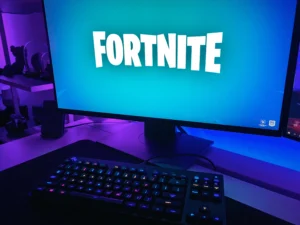Modern video games are specifically CPU-oriented, requiring high processing power; or GPU-oriented, requiring high graphic processing power; or CPU and GPU-oriented, requiring a god-level computer to run at top settings.
Fortnite is among the most downloaded video games on the planet, and it is played every day by armies of devoted gamers on various platforms. Fortnite, the wildly popular battle royale game, has taken the gaming world by storm. With its engaging gameplay, vibrant graphics, and competitive nature, players are constantly seeking ways to gain an edge over their opponents. Moreover, It contains a gorgeous, eye-catching map, 100-player real-time multiplayer matches, and numerous other features that will jam up all of your device’s components. So, is Fortnite more CPU or GPU-intensive? Let’s look into it.
Let’s look over Fortnite’s minimum and recommended system requirements according to Epic Games before getting into the details.

Minimum System Requirements
| Processor | Core i3-3225 3.3 GHz (Dual Core or Equivalent) |
| RAM | 4GB |
| Graphics Card | Intel HD 4000 2GB or AMD Equivalent |
| Operating System | Windows 7 |
Recommended System Requirements
| Processor | Intel Core i7-8700 or AMD Ryzen 7 3700x |
| RAM | 16GB |
| Graphics Card | Nvidia GTX 1080 or AMD Radeon RX 5700 XT 4GB |
| Operating System | Windows 10 64-bit |
Understanding CPU and GPU
Before we dive into the heart of the matter, let’s first understand the roles of these two essential components in your gaming setup.
The Role of CPU in Fortnite

Your Central Processing Unit (CPU) is the brain of your computer. It handles various calculations, including game physics, AI, and overall game logic. But how much does it impact your Fortnite experience?
The Role of GPU in Fortnite

On the flip side, the Graphics Processing Unit (GPU) is responsible for rendering the stunning visuals in Fortnite. From character models to intricate landscapes, your GPU does the heavy lifting. But does it overshadow the CPU’s importance?
Is Fortnite CPU or GPU Heavy?

Yes, Fortnite requires a lot of quick calculations, making it a GPU-intensive game. Battles in the game can become resource-hungry once they get going. To perform these computations quickly and without lag, you need a strong GPU.
In brief, Fortnite will probably utilize your graphics card’s capabilities more than your processor’s, but don’t be fooled by this; more GPU usage does not always suggest that your processor speed is being completely wasted. CPU resources are used by all video games, however some use them more than others.
In addition, there are other additional options like Effects, Anti-aliasing, and Post Processing that depend on your graphics card. Your CPU must therefore exert some effort, but your GPU is still mostly responsible for the results.
The visuals of the game may not seem noticeably more demanding than those of other games because they have a more distinctive tone, but because of the visual processor and unique features the game uses, they actually require more VRAM.
Does CPU Affect Fortnite FPS?
The short answer is yes, your CPU can significantly impact Fortnite’s FPS. FPS is a crucial metric in any competitive game, as it directly affects how smoothly the game runs and how responsive your controls are. A high FPS is essential for quick reaction times and accurate aiming.
When your CPU struggles to keep up with Fortnite’s demands, it can lead to decreased FPS. This is especially noticeable during intense moments with numerous players, structures, and effects on the screen. To maintain a competitive edge, it’s crucial to ensure that your CPU is not a bottleneck for your FPS.
Here’s a table outlining recommended FPS (Frames Per Second) settings for playing Fortnite based on different scenarios and preferences:
| Scenario/Preference | Recommended FPS Settings |
|---|---|
| Competitive Play | 144 FPS or higher |
| Casual Play | 60 FPS or higher |
| Smooth Gameplay | 30 FPS or higher |
| High-Quality Graphics | 60 FPS or higher (with GPU) |
| Lower-End Hardware | 30 FPS (with lower-end GPU) |
| eSports and Tournaments | 240 FPS or higher (if possible) |
Keep in mind that achieving higher FPS requires a more powerful gaming rig, including a capable CPU and GPU, as well as appropriate in-game settings adjustments. Your choice of FPS should align with your hardware capabilities and gaming preferences.
Is Gaming More GPU or CPU Heavy?
Fortnite’s performance relies on both the CPU and GPU (Graphics Processing Unit). However, the degree to which each component affects performance varies depending on the game’s demands and your graphics settings.
CPU Intensive Tasks: As mentioned earlier, the CPU handles various calculations and processes in Fortnite, such as physics and AI. During moments when the game requires these calculations, your CPU will become the bottleneck. This is especially true in the early game when multiple players are in close proximity, building structures, and engaging in combat.
GPU Intensive Tasks: On the other hand, the GPU is primarily responsible for rendering graphics, textures, and effects. When you increase the graphics settings or resolution in Fortnite, the GPU becomes more critical. High-quality textures, shadows, and visual effects demand more GPU power. If you want to play Fortnite at higher resolutions and with stunning visuals, investing in a powerful GPU is essential.
Nevertheless, you need a powerful GPU to enjoy features like anti-aliasing, shadows, textures, and effects.
Here’s a table listing good CPU and GPU combinations for playing Fortnite:
| CPU Model | GPU Model |
|---|---|
| Intel Core i5-12600K | Nvidia GeForce RTX 3060 |
| AMD Ryzen 5 5600X | AMD Radeon RX 6700 XT |
| Intel Core i7-12700K | Nvidia GeForce RTX 3070 |
| AMD Ryzen 7 5800X | Nvidia GeForce RTX 3080 |
| Intel Core i9-12900K | Nvidia GeForce RTX 3090 |
These combinations offer a range of performance levels to cater to different budget and gaming needs. For the best experience, ensure you have sufficient RAM and a compatible motherboard. Keep in mind that Fortnite’s performance can also be affected by factors like RAM speed and storage type, so consider those when building your gaming PC.
Final Thoughts
In summary, your graphics card is more important to the Fortnite game than your CPU. Everything in the game, including the cartoonish environment, textures, shadows, effects, etc., depends on how powerful your graphics card is.
If you use a strong graphics card, you can play Fortnite at 1080p Epic settings without any trouble. It is preferable to get a quad-core CPU that is highly compatible with your graphics card if you want to sustain frame rates exceeding 60 frames per second.
As we wrap up this epic battle between CPU and GPU, remember that the best setup is the one that suits your gaming style. Victory in Fortnite is not solely defined by hardware prowess but by your skills and strategies as well. So, gear up, drop into the island, and may your Victory Royales be plentiful!
FAQs
1. Does overclocking my CPU or GPU improve Fortnite performance?
Yes, overclocking can lead to performance improvements, but it also comes with risks. Make sure you do it safely and monitor temperatures.
2. What’s the ideal frame rate for Fortnite?
A consistent frame rate of 60 FPS or higher is recommended for a smooth gaming experience in Fortnite.
3. Can I play Fortnite on a laptop with integrated graphics?
You can, but for the best experience, a dedicated GPU is strongly recommended.
4. Are there any in-game settings I should tweak for better performance?
Lowering graphics settings, reducing resolution, and disabling unnecessary background applications can boost your performance.
